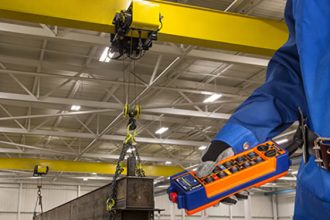Crane Equipment 101: Covering The Fundamentals Of This Overhead Handling Technology

Engineered to move large, heavy, and bulky loads, overhead crane equipment lifts, lowers and moves its payload horizontally through the overhead space in a facility. Also sometimes called a crane, an industrial crane, or an overhead traveling crane, this technology is built with high lifting capacities for multi-directional load movement. With a crane’s installation, an operation can avoid the need to transport or maneuver loads on the floor, through aisles, and around other obstacles. Cranes boost handling efficiency and throughput while optimizing facility space, minimizing product damage, and increasing employee safety.
There are a variety of applications for cranes both within the four walls of a facility and outdoors. Used to support manufacturing processes (such as staging and assembly for work-in-process), warehousing storage, and loading and unloading activities, cranes are also found in yards, at shipping ports, and at railroad depots.
Crane travel (either electric or pneumatic powered) is controlled by an operator, who directs its function manually or with a wired pendant station or wireless controls. Each crane installation is built to cover a rectangular area, transporting a load side to side, backwards, and forwards. A hoist to lift and lower the load is mounted to a trolley that moves side to side across a bridge beam. For front to back travel, the bridge beam — riding on end trucks at each end of the beam — glides over one (or more) horizontal girders.
Although the equipment is typically built from standard components, no two crane applications are the same. Therefore, a variety of different types of cranes (and attachments) are available to suit unique operational needs. These include:
- Single Girder Crane – Equipped with a single bridge beam attached to two runways. The hoist runs on the bottom flange of the bridge beam, which is why this type of overhead system is sometimes referred to as an under-running or under-hung crane. These are usually used in applications with less than 15 tons capacity, spans below 70 feet and Class C applications.
- Double Girder Crane – Also known as a top-running crane, these systems utilize two bridge beams set atop the runway end trucks. The hoist and trolley are typically mounted on top of the two bridge beams to create greater headroom under the crane. These are used for heavier capacity and higher duty applications.
- Box Girder Crane – In this style, a four-sided box configuration is used when fabricating the bridge girder to increase load capacity and/or accommodate wider bridge spans. These cranes are frequently used in pairs with the hoist operating on rails attached to the top of each girder.
- Truss Girder Crane – To further increase a crane’s loading capacity and span distance, this style utilizes structurally reinforced bridge girders.
- I-Beam Crane – The bridge girder is made of a standard I-beam; runway beams may or may not also be of I-beam construction.
- Straddle Crane – Frequently mounted on wheels, these free-standing cranes are designed to straddle a load. This type is most commonly found in lumber yards and seaports for handling shipping containers.
- Tower Crane – Fixed or portable, these cranes are most frequently found on construction sites for handling large, heavy loads and lifting them high overhead. They are also often used for loading and unloading shipping containers at seaports.
- Stacker Crane – Similar in appearance to a conventional bridge crane, these systems are utilized without a hoist. Instead they are outfitted with a rotating ridged or telescoping mast suspended from the bridge trolley and a load handling device such as single or double forks or a gripping lifter.
Looking for more information on overhead crane systems? The members of the Crane Manufacturers Association of America (CMAA) represent the industry’s leading suppliers of overhead crane systems and are available to answer any questions. Additionally, the group offers a variety of resources—including buyers’ guides, engineering specifications, OSHA Alliance safety tip and fact sheets, inspection and maintenance checklists, safety seminars and more—via its website at www.MHI.org/CMAA.



